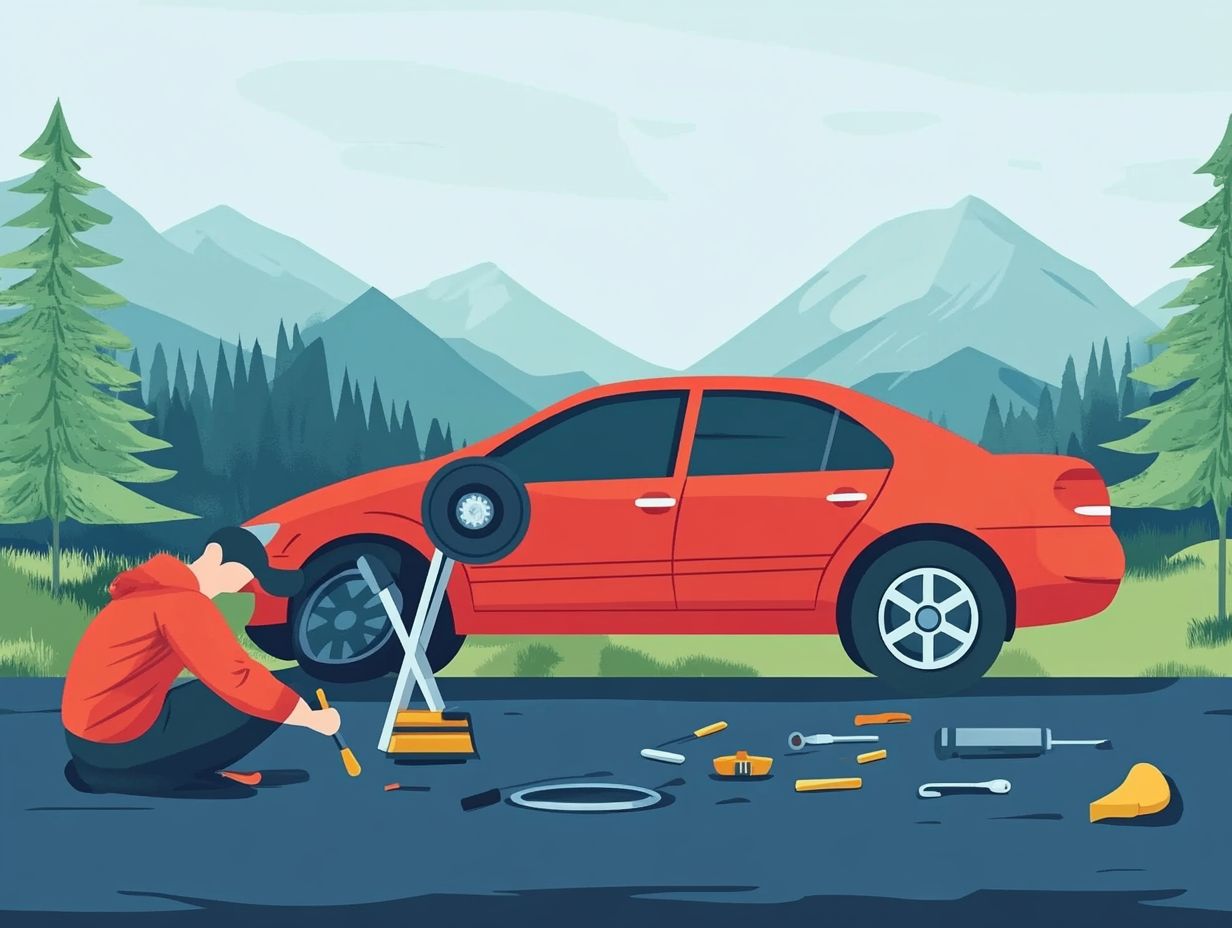How to Handle a Flat Tire?
Flat tires can be a frustrating and inconvenient experience for you as a driver.
Understanding the causes and types of flat tires is essential for your prevention and preparation. This guide will equip you with the tools you need and walk you through a step-by-step process for changing a tire. You’ll be ready when the unexpected occurs.
It will also cover maintenance tips to help you avoid flats. Additionally, we’ll explore options if you find yourself without a spare.
Jump in and become a flat tire expert today!
Contents
Key Takeaways:

- Always be prepared by having the necessary tools and equipment in your car for changing a flat tire.
- Regular maintenance and inspection of your tires can help prevent flat tires and ensure your safety on the road.
- If you don’t have a spare tire, consider alternative solutions such as using a tire repair kit or calling for roadside assistance.
Understanding Flat Tires
Every driver must understand flat tires since they can strike unexpectedly. This disruption can create unsafe driving conditions.
A flat tire can arise from various factors, including damage from road debris, improper tire pressure, or challenging driving environments.
By maintaining your vehicle and being aware of its tire safety features, you can significantly reduce the risk of encountering a flat tire. Knowing how to address this situation enhances your road safety and ensures you’re prepared for any emergencies that may arise.
Causes and Types of Flat Tires
Flat tires can emerge from a variety of causes. Understanding these can enhance your preparedness for emergencies.
Punctures from sharp objects on the road often catch drivers off guard, leaving them stranded when they least expect it. Blowouts, which typically result from under-inflation or excessive wear, can lead to a sudden loss of control, presenting serious safety hazards.
Sidewall damage can happen if you hit potholes or curbs. Regularly inspect your tires for any signs of wear or damage.
Learn how to use tire repair kits. This knowledge adds valuable security during emergencies. Understanding when to call for roadside assistance enables you to navigate unexpected challenges with assurance.
Preparation for Handling a Flat Tire
Preparation is vital when managing a flat tire. Having the right tools and knowledge can greatly alleviate stress in an emergency.
Ensure that your vehicle is equipped with a tire repair kit, a sturdy car jack, lug nuts, and a spare tire, all within easy reach.
Including a tire inflator and a pressure gauge to monitor tire health is also wise. Familiarize yourself with the procedure for making an emergency call for roadside assistance to streamline the recovery process.
Essential Tools and Equipment

Having the right tools and equipment is essential for effectively tackling a flat tire and ensuring your safety on the road.
A car jack provides the necessary lift to safely elevate your vehicle, granting you easy access to the troublesome tire. A lug wrench is critical for loosening and tightening the lug nuts, ensuring your new tire is securely fastened.
A tire inflator can truly be a lifesaver, helping you maintain optimal tire pressure after a change. Keeping a spare tire on hand can make all the difference in an emergency. It s equally important to ensure your tire repair kit is updated for quick fixes, enhancing your overall tire safety.
Step-by-Step Guide to Changing a Flat Tire
Changing a flat tire is a valuable skill for every driver. Adhering to a step-by-step guide can guarantee that you perform the task safely and efficiently, so you can get back on the road quickly.
- Start by assessing the flat tire to gauge the extent of the damage.
- Gather the necessary tools, such as a car jack and a spare tire.
- Loosen the lug nuts before lifting the vehicle. Ensure that essential safety features are activated like your emergency lights to alert other drivers of your situation.
Removing the Flat Tire
Removing a flat tire requires your focus and the right method to ensure both safety and efficiency. It s essential to follow the right steps.
Before you lift the vehicle, it s imperative to loosen the lug nuts while the tire remains on the ground. This simple action prevents the tire from spinning, making your task significantly easier. Once the lug nuts are loosened, use a car jack to elevate the vehicle safely. After that, you can completely remove the lug nuts and take off the flat tire.
With the tire removed, it s time to assess any damage. This assessment will help you determine whether a straightforward repair is feasible or if a full replacement is necessary. By checking for visible punctures, cracks, or uneven wear, you ll gain valuable insights into the tire s condition.
Replacing with a Spare Tire
Replacing a flat tire with a spare tire is a straightforward task, but it demands your attention to detail to ensure the spare is installed safely and ready for action.
By following a few simple steps, you can significantly enhance your safety on the road.
- First, make sure to secure your vehicle on a level surface and activate the hazard lights for visibility.
- Once the flat tire is off, position the spare properly before installing it.
- Don t forget to tighten the lug nuts according to the manufacturer s specifications; this prevents any accidents due to loose fittings.
- Before you hit the road, check the tire pressure (the amount of air in your tires) of the spare to ensure optimal performance and stability.
Knowing how safety features affect the spare tire can help you avoid problems, allowing for a more confident driving experience.
Tips for Preventing Flat Tires

Preventing flat tires is essential for your safety on the road and minimizing the risk of emergency situations. Regular maintenance and vigilance are key components of effective tire care.
One of the most important strategies for tire safety is maintaining optimal tire pressure. Remember, both under-inflated and over-inflated tires can lead to increased wear or even damage. Additionally, being mindful of driving conditions like steering clear of road debris and paying attention to signs of tire wear can greatly diminish the likelihood of encountering a flat tire.
Regular Maintenance and Inspection
Regular inspection of your tires is essential for ensuring their longevity and performance, helping you avert common issues that lead to flat tires.
But it s not just about dodging flats; diligent tire care is crucial for maximizing fuel efficiency and enhancing handling. By checking your tire pressure at least once a month, you can enjoy better gas mileage, which not only saves you money but also minimizes your environmental footprint.
Keeping an eye on tire wear allows you to spot uneven patterns that might signal alignment issues or suspension problems. When you prioritize these straightforward yet impactful practices, you not only extend the life of your tires but also significantly boost your vehicle’s safety, providing you with peace of mind on every journey.
What to Do If You Don’t Have a Spare Tire
In the unfortunate event that you face a flat tire without a spare, knowing the steps to take after a flat tire can help you navigate the situation with ease and confidence.
First, take a moment to assess the damage and see if a tire repair kit might serve as a temporary fix. If that’s not an option, don t hesitate to make an emergency call for roadside assistance; they can swiftly provide solutions, whether it s a tow or a professional tire replacement.
Furthermore, being familiar with your car warranty and insurance policy can significantly streamline your access to these services, ensuring you re back on the road without unnecessary delays.
Take these steps to prevent flat tires and stay safe on the road!
Alternative Solutions
Flat tires can happen to anyone. But don t worry! Act quickly to ensure your safety and mobility by exploring alternative solutions.
Having a tire repair kit handy can be very helpful. It allows you to inflate the tire and seal minor punctures, so you can drive to a repair shop safely.
It s also important to know when to dial for roadside assistance, especially if the damage needs more than just a simple patch-up.
Understanding the services provided by towing companies can significantly reduce your stress. They can transport your vehicle to a safe location or a repair facility without a hitch. By being prepared, you can tackle these challenges with confidence and ease.
Frequently Asked Questions

What do I do if I get a flat tire?
If you get a flat tire while driving, the first thing to do is safely pull over to the side of the road.
How do I know if I have a flat tire?
You may feel the car pulling to one side or notice a loud flapping or thumping sound. Your tire pressure light may also turn on.
Can I still drive on a flat tire?
It is not recommended to drive on a flat tire as it can damage your rim and potentially lead to a more serious accident.
What tools do I need to change a flat tire?
You will need a spare tire, a jack, and a lug wrench. It is also helpful to have a flashlight and gloves.
How do I change a flat tire?
First, loosen the lug nuts, then jack up the car. Remove the lug nuts and old tire, and replace it with the spare. Finally, lower the car and tighten the lug nuts.
Do I need to call for roadside assistance to change a flat tire?
If you are unsure how to change a flat tire or do not have the necessary tools, it is best to call for roadside assistance for help.
Check your tire repair kit today so you’re ready for any surprise flat tires!






